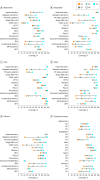Progress Toward Universal Health Coverage: A Comparative Analysis in 5 South Asian Countries
- PMID: 28759681
- PMCID: PMC5710570
- DOI: 10.1001/jamainternmed.2017.3133
Progress Toward Universal Health Coverage: A Comparative Analysis in 5 South Asian Countries
Abstract
Importance: Achieving universal health coverage is one of the key targets in the newly adopted Sustainable Development Goals of the United Nations.
Objective: To investigate progress toward universal health coverage in 5 South Asian countries and assess inequalities in health services and financial risk protection indicators.
Design and settings: In a population-based study, nationally representative household (335 373 households) survey data from Afghanistan (2014 and 2015), Bangladesh (2010 and 2014), India (2012 and 2014), Nepal (2014 and 2015), and Pakistan (2014) were used to calculate relative indices of health coverage, financial risk protection, and inequality in coverage among wealth quintiles. The study was conducted from June 2012 to February 2016.
Main outcomes and measures: Three dimensions of universal health coverage were assessed: access to basic services, financial risk protection, and equity. Composite and indicator-specific coverage rates, stratified by wealth quintiles, were then estimated. Slope and relative index of inequality were used to assess inequalities in service and financial indicators.
Results: Access to basic care varied substantially across all South Asian countries, with mean rates of overall prevention coverage and treatment coverage of 53.0% (95% CI, 42.2%-63.6%) and 51.2% (95% CI, 45.2%-57.1%) in Afghanistan, 76.5% (95% CI, 61.0%-89.0%) and 44.8% (95% CI, 37.1%-52.5%) in Bangladesh, 74.2% (95% CI, 57.0%-88.1%) and 83.5% (95% CI, 54.4%-99.1%) in India, 76.8% (95% CI, 66.5%-85.7%) and 57.8% (95% CI, 50.1%-65.4%) in Nepal, and 69.8% (95% CI, 58.3%-80.2%) and 50.4% (95% CI, 37.1%-63.6%) in Pakistan. Financial risk protection was generally low, with 15.3% (95% CI, 14.7%-16.0%) of respondents in Afghanistan, 15.8% (95% CI, 14.9%-16.8%) in Bangladesh, 17.9% (95% CI, 17.7%-18.2%) in India, 11.8% (95% CI, 11.8%-11.9%) in Nepal, and 4.4% (95% CI, 4.0%-4.9%) in Pakistan reporting incurred catastrophic payments due to health care costs. Access to at least 4 antenatal care visits, institutional delivery, and presence of skilled attendant during delivery were at least 3 times higher among the wealthiest mothers in Afghanistan, Bangladesh, Nepal, and Pakistan compared with the rates among poor mothers. Access to institutional delivery was 60 to 65 percentage points higher among wealthy than poor mothers in Afghanistan, Bangladesh, Nepal, and Pakistan compared with 21 percentage points higher in India. Coverage was least equitable among the countries for adequate sanitation, institutional delivery, and the presence of skilled birth attendants.
Conclusions and relevance: Health coverage and financial risk protection was low, and inequality in access to health care remains a serious issue for these South Asian countries. Greater progress is needed to improve treatment and preventive services and financial security.
Conflict of interest statement
Figures

Comment in
-
Outcomes in South Asia Matter for the World.JAMA Intern Med. 2017 Sep 1;177(9):1306-1307. doi: 10.1001/jamainternmed.2017.3140. JAMA Intern Med. 2017. PMID: 28759683 No abstract available.
References
-
- United Nations Sustainable Development knowledge platform. Sustainable Development goal. https://sustainabledevelopment.un.org/. Accessed October 7, 2015.
-
- World Health Organization Monitoring Progress Towards Universal Health Coverage at Country and Global Levels: Framework, Measures and Targets Geneva, Switzerland: World Health Organization and International Bank for Reconstruction and Development, World Bank; 2014.
-
- World Health Organization Tracking Universal Health Coverage: First Global Monitoring Report. Geneva, Switzerland: World Health Organization; 2015.
-
- Schmidt H, Gostin LO, Emanuel EJ. Public health, universal health coverage, and Sustainable Development goals: can they coexist? Lancet. 2015;386(9996):928-930. - PubMed
Publication types
MeSH terms
LinkOut - more resources
Full Text Sources
Other Literature Sources
Medical

